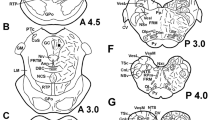Summary
The functional morphology of the neuroendocrine system producing sodium influx-stimulating (SIS) peptide in the pond snail, Lymnaea stagnalis, was studied by in situ hybridization and immunocytochemistry. The SIS-peptide, which is 76 amino acids long, stimulates sodium uptake from the ambient medium. Two synthetic DNA probes were used for in situ hybridization. The nucleotide sequences were chosen from the cDNA structure; they encode amino acids 8–17 and 64–73, respectively. SIS-peptide sequences 10–20 and 67–76 were synthesized and antibodies were raised to them and affinity-purified. In addition to these antibodies, a monoclonal antibody raised to a bioactive, high-pressure liquid chromatography (HPLC)-purified brain extract was used for immunocytochemistry. Paraffin sections of central nervous systems and of whole snails were studied. The SIS-peptide system could be identified as the previously described yellow cell (YC) system by comparing alternate sections treated with the DNA probes, stained with the antibodies, or stained with alcian blue-alcian yellow. SIS-peptide neurons (∼45) occur in the ganglia of the visceral ring and in the proximal parts of visceral nerves. Axons run in the nerves of these and in several nerves of other ganglia. Numerous axon branches penetrate the perineurium forming a vast central neurohemal area. The SIS-peptide system innervates the pericardium, the nephridial gland, the reno-pericardial canal, the ureter, the spermoviduct and gonadal acini, the anterior aorta, the ventral buccal artery, and the penis protractor muscle. The morphology of the system is discussed in relation to the process of sodium ion uptake from the ambient medium and from pro-urine, and to that of regulating blood pressure. In the central nervous system and other organs, neurons and axons not labeled with the DNA probes, but immunoreactive to one or two of the antibodies, were observed. It seems unlikely that these elements are functionally related to the SIS-peptide system.
Similar content being viewed by others
References
Aardt WJ van (1968) Quantitative aspects of the water balance in Lymnaea stagnalis (L.). Neth J Zool 18:253–312
Andrews EB, Little C (1972) Ultrafiltration in the gastropod heart. Nature 234:411–412
Bekius R (1972) The circulatory system of :ymnaea stagnalis. Neth J Zool 22:1–58
Croll RP, Chiasson BJ (1989) Postembryonic development of the serotonin-like immunoreactivity in the central nervous system of the snail Lymnaea stagnalis. J Comp Neurol 280:122–142
Dirks RW, Raap AK, Minnen J van, Vreugdenhil E, Smit AB, Ploeg M van der (1989) Detection of mRNA molecule coding neuropeptide hormones of the pond snail Lymnaea stagnalis by radioactive and non-radioactive in situ hybridization: a model study for mRNA detection. J Histochem Cytochem 37:7–14
Greenaway P (1970) Sodium regulation in the freshwater mollusc Lymnea stagnalis (L.) (Gastropoda: Pulmonata). J Exp Biol 53:147–163
Jong-Brink M de, With ND de, Hurkmans JM, Bergamin-Sassen M (1984) A morphological, enzyme-cytochemical, and physiological study of the blood-gonad barrier in the hermaphrodite snail Lymnaea stagnalis. Cell Tissue Res 235:593–600
Minnen J van, Boer HH (1987) Generation and application of monoclonal antibodies raised against homogenates of whole central nervous systems of the pond snail Lymnaea stagnalis. Proc Kon Ned Akad Wet C90:193–201
Minnen J van, Haar C van der, Raap AK, Vreugdenhil E (1988) Localization of ovolation hormone-like neuropeptide in the CNS of the snail Lymnaea stagnalis by means of immunocytochemistry and in situ hybridization. Cell Tissue Res 251:477–484
Plesch BEC, Janse C, Boer HH (1975) Gross morphology and histology of the musculature of the freshwater pulmonate Lymnaea stagnalis (L.). Neth J Zool 25:332–352
Soffe SR, Benjamin PR, Slade CT (1978) Effects of environmental osmolarity on blood composition and light microscope appearance of neurosecretory neurones in the snail, Lymnaea stagnalis (L.). Comp Biochem Physiol 61A:577–584
Soffe SR, Slade CT, Benjamin PR (1979) Environmental osmolarity and neurosecretory neurones in Lymnaea stagnalis (L.). Malacologia 18:583–586
Swindale NV, Benjamin PR (1976) The anatomy of neurosecretory neurones in the pond snail Lymnaea stagnalis (L.). Philos Trans R Soc Lond [Biol] 274:169–202
Wendelaar Bonga SE (1970) Ultrastructure and histochemistry of neurosecretory cells and neurohaemal areas in the pond snail Lymnaea stagnalis (L.). Z Zellforsch 108:190–224
Wendelaar Bonga SE (1972) Neuroendocrine involvement in osmoregulation in a freshwater mollusc, Lymnaea stagnalis. Gen Comp Endocrinol [Suppl] 3:308–316
Wendelaar Bonga SE, Boer HH (1969) Ultrastructure of the renopericardial system in the pond snail Lymnaea stagnalis (L.). Z Zellforsch 94:513–529
With ND de (1977) Evidence for the independent regulation of specific ions in the haemolymph of Lymnaea stagnalis (L.). Proc Kon Ned Akad Wet C80:144–158
With ND de (1980) Water turn-over, ultrafiltration, renal water reabsorption and renal circulation in fed and starved specimens of Lymnaea stagnalis, adapted to different external osmolarities. Proc Kon Ned Akad Wet C83:109–120
With ND de, Schors RC van der (1982) On the interrelations of the Na+ and Cl- influxes in the pulmonate freshwater snail Lymnaea stagnalis. J Comp Physiol 148:131–135
With ND de, Schors RC van der (1984) Urine composition and kidney function in the pulmonate freshwater snail Lymnaea stagnalis. Comp Biochem Physiol 79A:99–103
With ND de, Ebberink RHM, Schors RC van der (1987) Neurohormonal control of sodium metabolism in the pulmonate freshwater snail Lymnaea stagnalis. In: Boer HH, Geraerts WPM, Joosse J (eds) Neurobiology, molluscan models. North-Holland, Amsterdam Oxford New York, pp 357–360
With ND de, Slootstra JW, Schors RC van der (1988) The bioelectrical activity of the body wall of the pulmonate freshwater snail Lymnaea stagnalis: effects of neurotransmitters and the sodium influx stimulating neuropeptide. Gen Comp Endocrinol 70:216–223
With ND de, Li KW, Minnen J van, Schors RC van der, Smit AB, Thijssen SFT, Boer HH (1991) Neuroendocrine control of hydromineral regulation in the freshwater snail Lymnaea stagnalis. In: Kits KS, Boer HH, Joosse J (eds) Molluscan neurobiology. North-Holland, Amsterdam, pp 335–339
Author information
Authors and Affiliations
Rights and permissions
About this article
Cite this article
Boer, H.H., Montagne-Wajer, C., van Minnen, J. et al. Functional morphology of the neuroendocrine sodium influx-stimulating peptide system of the pond snail, Lymnaea stagnalis, studied by in situ hybridization and immunocytochemistry. Cell Tissue Res 268, 559–566 (1992). https://doi.org/10.1007/BF00319163
Received:
Accepted:
Issue Date:
DOI: https://doi.org/10.1007/BF00319163




